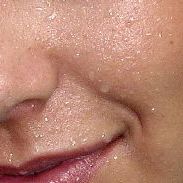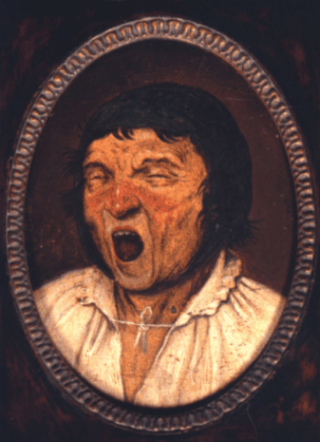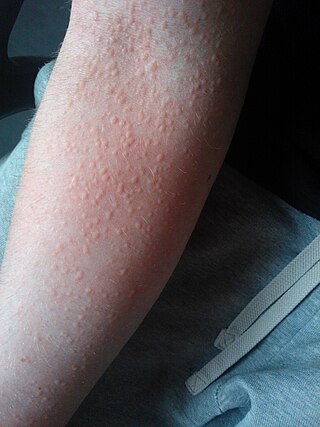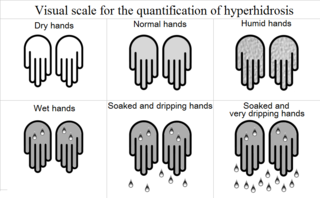External links
- The New Yorker - CRIMSON TIDE - What is blushing?, No one knows for sure, but it can ruin your life by Atul Gawande.
Idiopathic craniofacial erythema is a medical condition characterized by uncontrollable and frequently unprovoked facial blushing.
Blushing can occur at any time and is frequently triggered by even mundane events, such as talking to friends, paying for goods in a shop, asking for directions or even simply making eye contact with another person.
This medical condition characterized by severe, frequent and uncontrollable reddening of the face, which is often unprovoked. It is unknown why people are afflicted with this condition, but it is appears to be the result of an overactive sympathetic nervous system, an automatic response which sufferers have no mental control over. It is related to focal hyperhidrosis, more commonly known as excessive sweating, as it is caused by the same overactive nerves which cause excessive sweating. Sufferers of severe facial blushing commonly experience focal hyperhidrosis. Studies have also shown that patients with severe facial blushing or focal hyperhidrosis commonly have family members with one or both of the related disorders.[ citation needed ]
A number of treatments are available. Options for conservative treatment for chronic blushing include oral medications and behavioral therapy. Several types of medications are used as treatment for idiopathic craniofacial erythema. Anxiolytics, such as Valium®, are used for anxiety; beta-blockers, which blunt the body’s reaction to stress; or anticholinergic drugs, such as robinol, ditropan, or propanthelin.3.
The most successful non-invasive procedure is cognitive behavioural therapy (CBT), which attempts to alleviate the anxiety felt by sufferers.
In extreme cases a surgical procedure known as endoscopic transthoracic sympathicotomy (ETS) is available. Pioneered by surgeons in Sweden, this procedure has recently become increasingly controversial due to its many potential adverse effects. Patients who have undergone the procedure frequently complain of compensatory sweating and fatigue, with around 5% reconsidering getting the treatment. ETS is now normally only considered in extreme cases where other treatments have been ineffective.

Perspiration, also known as sweat, is the fluid secreted by sweat glands in the skin of mammals.

Blushing or erubescence is the reddening of a person's face due to psychological reasons. It is normally involuntary and triggered by emotional stress associated with passion, embarrassment, shyness, fear, anger, or romantic stimulation.

Rosacea is a long-term skin condition that typically affects the face. It results in redness, pimples, swelling, and small and superficial dilated blood vessels. Often, the nose, cheeks, forehead, and chin are most involved. A red, enlarged nose may occur in severe disease, a condition known as rhinophyma.

Hyperhidrosis is a medical condition in which a person exhibits excessive sweating, more than is required for the regulation of body temperature. Although it is primarily a physical burden, hyperhidrosis can deteriorate the quality of life of the people who are affected from a psychological, emotional, and social perspective. In fact, hyperhidrosis almost always leads to psychological as well as physical and social consequences. People suffering from it present difficulties in professional fields, more than 80% experiencing a moderate to severe emotional impact from the disease and half are subject to depression.
Endoscopic thoracic sympathectomy (ETS) is a surgical procedure in which a portion of the sympathetic nerve trunk in the thoracic region is destroyed. ETS is used to treat excessive sweating in certain parts of the body, facial flushing, Raynaud's disease and reflex sympathetic dystrophy. By far the most common complaint treated with ETS is sweaty palms. The intervention is controversial and illegal in some jurisdictions. Like any surgical procedure, it has risks; the endoscopic sympathetic block (ESB) procedure and those procedures that affect fewer nerves have lower risks.
Taijin kyofusho is a Japanese culture-specific syndrome. The term taijin kyofusho translates into the disorder (sho) of fear (kyofu) of interpersonal relations (taijin). Those who have taijin kyofusho are likely to be extremely embarrassed about themselves or fearful of displeasing others when it comes to the functions of their bodies or their appearances. These bodily functions and appearances include their faces, odor, actions, or looks. They do not want to embarrass other people with their presence. This culture-bound syndrome is a social phobia based on fear and anxiety.
Hemifacial spasm (HFS) is a rare neuromuscular disease characterized by irregular, involuntary muscle contractions (spasms) on one side (hemi-) of the face (-facial). The facial muscles are controlled by the facial nerve, which originates at the brainstem and exits the skull below the ear where it separates into five main branches.

Meige's syndrome is a type of dystonia. It is also known as Brueghel's syndrome and oral facial dystonia. It is actually a combination of two forms of dystonia, blepharospasm and oromandibular dystonia (OMD).

Oxybutynin, sold under the brand name Ditropan among others, is an anticholinergic medication primarily used to treat overactive bladder. It is widely considered a first-line therapy for overactive bladder due to its well-studied side effect profile, broad applicability, and continued efficacy over long periods of time. It works similar to tolterodine, darifenacin, and solifenacin, although it is usually preferred over these medications. It is sometimes used off-label for treatment of hyperhidrosis, or excessive sweating. It has also been used off-label to treat bedwetting in children, but this use has declined, as it is most likely ineffective in this role. It is taken by mouth or applied to the skin.

Compensatory hyperhidrosis is a form of neuropathy. It is encountered in patients with myelopathy, thoracic disease, cerebrovascular disease, nerve trauma or after surgeries. The exact mechanism of the phenomenon is poorly understood. It is attributed to the perception in the hypothalamus (brain) that the body temperature is too high. The sweating is induced to reduce body heat.

Frey's syndrome is a rare neurological disorder resulting from damage to or near the parotid glands responsible for making saliva, and from damage to the auriculotemporal nerve often from surgery.

Cholinergic urticaria or also known as (CholU) and CU, is a rare form of hives (urticaria) that is triggered by an elevation in body temperature, breaking a sweat, or exposure to heat. It is also sometimes called exercise-induced urticaria or heat hives. The condition is considered to be one of the many rarest forms of allergies known to medical science.
Social anxiety is the anxiety and fear specifically linked to being in social settings. Some categories of disorders associated with social anxiety include anxiety disorders, mood disorders, autism spectrum disorders, eating disorders, and substance use disorders. Individuals with higher levels of social anxiety often avert their gazes, show fewer facial expressions, and show difficulty with initiating and maintaining a conversation. Social anxiety commonly manifests itself in the teenage years and can be persistent throughout life; however, people who experience problems in their daily functioning for an extended period of time can develop social anxiety disorder. Trait social anxiety, the stable tendency to experience this anxiety, can be distinguished from state anxiety, the momentary response to a particular social stimulus. Half of the individuals with any social fears meet the criteria for social anxiety disorder. Age, culture, and gender impact the severity of this disorder. The function of social anxiety is to increase arousal and attention to social interactions, inhibit unwanted social behavior, and motivate preparation for future social situations.
Racing thoughts refers to the rapid thought patterns that often occur in manic, hypomanic, or mixed episodes. While racing thoughts are most commonly described in people with bipolar disorder and sleep apnea, they are also common with anxiety disorders, obsessive–compulsive disorder (OCD), and other psychiatric disorders such as attention deficit hyperactivity disorder (ADHD). Racing thoughts are also associated with sleep deprivation, hyperthyroidism, and the use of amphetamines.

Palmoplantar hyperhidrosis is excessive sweating localized to the palms of the hands and soles of the feet. It is a form of focal hyperhidrosis in that the excessive sweating is limited to a specific region of the body. As with other types of focal hyperhidrosis the sweating tends to worsen during warm weather.
Idiopathic hypersomnia(IH) is a neurological disorder which is characterized primarily by excessive sleep and excessive daytime sleepiness (EDS). Idiopathic hypersomnia was first described by Bedrich Roth in 1976, and it can be divided into two forms: polysymptomatic and monosymptomatic. The condition typically becomes evident in early adulthood and most patients diagnosed with IH will have had the disorder for many years prior to their diagnosis. As of August 2021, an FDA-approved medication exists for IH called Xywav, which is an oral solution of calcium, magnesium, potassium, and sodium oxybates; in addition to several off-label treatments (primarily FDA-approved narcolepsy medications).

Focal hyperhidrosis, also known as primary hyperhidrosis, is a disease characterized by an excessive sweating localized in certain body regions. Studies suggest that this condition, affecting between 1% and 3% of the US population, seems to have a genetic predisposition in about two thirds of those affected.
Acquired idiopathic generalized anhidrosis (AIGA) is characterized by generalized absence of sweating without other autonomic and neurologic dysfunction. Other symptoms include facial flushing, headaches, disorientation, lassitude, hyperthermia, weakness, and palpitations.
An epilepsy syndrome is defined as "a characteristic cluster of clinical and Electroencephalography (EEG) features, often supported by specific etiological findings ."

Topical steroid withdrawal, also known as red burning skin and steroid dermatitis, has been reported in people who apply topical steroids for 2 weeks or longer and then discontinue use. Symptoms affect the skin and include redness, a burning sensation, and itchiness, which may then be followed by peeling.